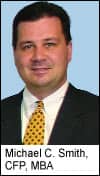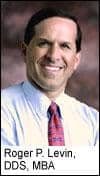by Roger P. Levin, DDS, MBA, and Michael C. Smith, CFP, MBA
Your retirement plan should fit the size of your practice
 |
 |
Most orthodontic practices have increased in capacity since 1990, thanks largely to advances in technology, technique, and patient management. During the last 15 years, many of my clients have doubled their capacity with regard to production and patient flow. Expanded capacity increases productivity by allowing orthodontists to see significantly more patients without any increase in fixed overhead. Some orthodontic practices have achieved 20%–30% increases in production without any escalation in staff stress.
Only by using step-by-step, proven business systems can orthodontic practices reach the levels of production that are currently being enjoyed by a percentage of practices. Such success has led to far greater income for orthodontists and an increase in opportunities for the dental team. Unfortunately, increased income does not automatically translate into better retirement planning or retirement funding. Levin Group research indicates that only 3%–5% of all orthodontists can comfortably retire by the age of 60. Setting up a retirement plan for the practice can help orthodontists achieve early financial independence and maintain a comfortable lifestyle during retirement.
The Right Plan For Your Practice
Designing a retirement plan for orthodontic practices depends on several key factors, including practice and staff size, income, the orthodontist’s age, the current retirement plan, and practice goals. Starting a structured retirement plan allows the orthodontist to reap significant tax savings now, while accruing a large asset in the future. When financial planning is done correctly, it will provide a pathway to a comfortable lifestyle for the physician in retirement.
For example, if an orthodontist contributed $40,000 into a retirement plan annually for 20 years and the plan averaged an 8% rate of return, the orthodontist would have accrued approximately $2 million.
A quality retirement plan can be a critical factor in retaining key staff members. Most orthodontists who have lost core personnel know how difficult and time-consuming it can be to find and train new staff members. Implementing a retirement plan—and then educating team members as to its value—can help reduce staff turnover. The cost of hiring, training, and compensating an employee often pale in comparison to the cost of the inefficiencies created by staff turnover. New staff members often take months to learn their responsibilities and become effective members of the team. This transition period can be extremely stressful for the rest of the team, who are working harder to compensate for any deficiencies in the new team member’s performance until he or she is completely trained and up-to-speed. Finding ways to retain quality staff members is important to the long-term success of a practice.
In addition to staff retention, another often-overlooked benefit of retirement plans is tax savings. In most plans, the cost of contributions, administration, and other associated things is a direct expense for the practice and can reduce the practice’s income tax burden. Given that orthodontists often find themselves in the top marginal tax bracket, the tax savings can be significant. For those who live in a state with a high tax rate, every $1,000 contributed to a qualified retirement plan can reduce the orthodontist’s tax burden by up to $450.
Not only can the contributions reduce current taxation, but the money invested in various plans also grows tax-deferred until it is withdrawn at the age of retirement, at which point most orthodontists will be in a significantly lower tax bracket.
Time to Reevaluate
For orthodontists who have a retirement plan in place, now may be the time to reevaluate their current plans. Many legislative changes have occurred during the last several years that may affect already-established plans. The good news is that the IRS limits on contributions have increased for many plans. This means that orthodontists may contribute more to their plans than they could in prior years. A Certified Financial Planner can provide more specifics for your plan.
In addition to increased contribution limits, other significant changes have been made to existing plan types. More importantly, new types of plans are now available. As an orthodontist’s income grows and staff demographics change, orthodontists should periodically review their plans. The sheer number of plans available to orthodontists is staggering.
As an example, we will look at the search conducted by two different orthodontic practices: a small practice with one orthodontist and five staff members, and a large practice with three orthodontists and 30 staff members.
Small-Practice Analysis
The first orthodontist, Laura Petit, DDS, is nearly 50 years old and runs a solo practice formed as an S corporation. She has five staff members. She would like to find a younger associate to enter the practice within the next several years, and eventually sell her ownership stake to the associate over a period of years and leave the practice at age 60–65. The practice has experienced growth recently after implementing a new management and marketing plan. The practice’s collected revenue is $900,000 per year, and the orthodontist’s net income last year was $225,000. She annually contributes $3,000 to an IRA and $15,000 to a life insurance policy that invests in mutual funds. This has been her retirement plan for the past decade. After meeting with a Certified Financial Planner, she is considering several options:
1) a Simplified Employee Plan–Individual Retirement Account (SEP–IRA);
2) a 401(k) plan;
3) a “new comparability” 401(k) combined with a profit- sharing plan; and
4) a defined-benefit pension plan.
SEP–IRA: With the orthodontist’s compensation of $225,000, and staff compensation of roughly $175,000, Dr Petit would be able to contribute $41,000 to her portion of the SEP. She would also have to contribute nearly $32,000 for her staff, since all team members, including part-time staff, must be included in most SEP plans. The orthodontist would recognize only 56% of the total plan benefits—and this number can be significantly improved with other plans if that is the goal.
401(k) plan: With a traditional 401(k) plan, Dr Petit would be allowed a maximum contribution of $13,000 through salary deferral. Her contribution may be limited further if her staff does not contribute enough of their incomes to the plan due to “top-heavy” testing requirements. Traditional 401(k) plans must benefit all contributors evenly and not be tilted toward the heaviest contributors. It is clear that this alternative alone would not be sufficient to help Dr Petit retire in the time-frame that she has indicated.
New comparability 401(k) plan with profit-sharing: In this type of plan, the traditional 401(k) plan is used in combination with a profit-sharing plan. To negate the impact of the top-heavy testing requirements, a safe-harbor provision is added to the plan. This mandates that 3% of compensation is added to all participating employees’ accounts and, in exchange for this contribution, the orthodontist’s contribution is not reduced from the $13,000 maximum allowed. To increase the total dollars contributed on the orthodontist’s behalf, a profit-sharing component is added to the 401(k) plan.
The result of this combination is that Dr Petit could contribute $41,000 to her account in 2004 through the combination of salary deferral, safe-harbor contributions, and profit-sharing allocations. This amount will increase over time as contribution limits increase and “catch-up” contributions are allowed after age 50.
Her staff will receive a total of roughly $9,000 plus any contributions they make from their own salary deferrals. In this case, about 85% of the employer contribution (orthodontist plus staff) goes to the orthodontist, with approximately 15% going to staff. We strongly recommend that orthodontists work with a skilled plan administrator when dealing with these more complex plans, to maintain compliance with IRS guidelines.
Defined-benefit plan: Defined-benefit plans or traditional pension plans are viewed by many as retirement tools of the past. Many major corporations have eliminated or are in the process of eliminating their pension plans. While for large corporations a pension plan may be more costly than can be justified by shareholders, it may be one of the best vehicles available for the owners of small companies. Given that most orthodontic practices are not in the Fortune 500, it may be worth investigating. Defined-benefit plans are subject to tremendous regulation, so once again an orthodontist would be wise to work with skilled advisers to ensure compliance with all applicable laws.
For Dr Petit’s practice, this is what a defined-benefit plan would look like: The practice could contribute nearly $100,000 to a plan for the benefit of the orthodontist, while contributions for the benefit of her combined staff members would be slightly more than $20,000. This means that 80% of the benefit would accrue to the orthodontist, while providing the practice with a $120,000 tax deduction. Should this plan stay in effect until she leaves the practice, she could choose to take the pension in the form of income or a lump sum. Maximum annual income from the plan is $165,000 to the orthodontist; limits are the lesser of $165,000 or 100% of the average of the three highest-compensation years. The lump sum would be in excess of $1,200,000 with 6% investment returns. As you can see, this option is quite favorable for Dr Petit.
Dr Petit’s Decision: Dr Petit, after a thorough evaluation of these alternatives, narrowed her search to the new comparability 401(k) and the defined-benefit plan. She chose to implement the new comparability 401(k) plan with a profit-sharing component, while continuing to fund her IRA and reducing the contributions to her life insurance plan slightly.
Her primary reason for this decision was that employees could fund a portion of their 401(k) plan, whereas the practice would have to fund 100% of the defined-benefit plan. The cost of administration was also considerably higher for the defined-benefit plan, since it requires more actuarial testing than the 401(k) combination. The profit-sharing component also allows more flexibility than the defined-benefit plan, which must be funded in good years and bad.
These decisions must take into account many layers of analysis, and Dr Petit made a decision that will provide benefits to herself and her team members—and gives her staff a chance to take an active role in planning their financial futures.
Large-Practice Analysis
Hugh Green, DDS, is the senior partner in a three-orthodontist practice that is set up as a C corporation, including two partners and one associate who will become a partner in time. The practice collected $4.5 million last year. Dr Green’s W-2 compensation last year was $800,000, his partner earned $600,000, and their associate earned $250,000. They employ 30 team members and have an existing 401(k) plan, which the orthodontists fund with maximum contributions. Last year, the orthodontists each had to take $2,000 back from the plan to avoid the plan being considered top-heavy. After meeting with a Certified Financial Planner, they are considering several options:
1) a new comparability 401(k) plan with profit-sharing;
2) a nonqualified, deferred-compensation (NQDC) plan; and
3) a defined-benefit plan.
New comparability 401(k) plan with profit-sharing: This plan works for this practice exactly as it works for Dr Petit, with the orthodontists being able to target selected employees (themselves) for higher plan allocations. They could contribute $41,000 each: a combination of salary deferral, safe-harbor matching, and profit-sharing contributions. The practice’s overall contribution to the plan would be roughly $170,000, which again is a direct dollar-for-dollar expense for the practice and shields $170,000 from income taxation. The orthodontists’ share of the contributions would be $123,000—72% of the total plan benefit.
Nonqualified deferred compensation: This plan is very different from the others, as it is not an IRS-qualified plan. NQDC plans are subject to the general creditors of the practice, and are for the most part excluded from Employee Retirement Income Security Act requirements. They can be exempted from all testing requirements, as they are by definition “nonqualified” plans and can thus be set up to benefit only a certain class of employees—in this case, 100% of the benefits can accrue to the orthodontists. They would defer the receipt of income this year, instead putting the income into the NQDC plan. The assets, usually funded by mutual funds or insurance products, would grow, tax-deferred, until the orthodontist takes distributions. This method can only be used by practices that are formed as C corporations. S corporations and partnerships are ineligible for NQDC plans.
A key point about NQDC plans is that the practice cannot take a deduction until the benefits are paid to the orthodontist. Likewise, the orthodontist defers recognition of this income until it is actually received in the form of benefits.
The ideal situation for an NQDC plan to be implemented is when the orthodontists expect their incomes to be lower in the future (due to such things as retirement and working fewer hours) and expect corporate tax rates to remain the same or increase. In this case, the orthodontist receives the income and pays lower taxes on it, while the corporation gets a deduction of benefits paid (contributions plus growth) at higher tax rates, yielding tax savings on both the individual and corporate levels.
While it is difficult to predict future tax rates and legislation, the effect of deferring today’s income into future years is what makes this type of plan so attractive.
Defined-benefit plan: Like the defined-benefit pension plan outlined for Dr Petit, this plan could provide the orthodontists with an annual, postretirement income of $165,000 (today’s dollars indexed for inflation). Given that these plans tend to favor older employees and the highly compensated—and Dr Green is both the oldest and highest paid—it would benefit him more than the remaining employees. His partners will also benefit as they grow with the practice and bring in additional associates and future partners. For a highly successful orthodontic practice employing highly compensated orthodontists, this plan is very attractive. Greater than 75% of the benefits can accrue to the orthodontists, and the benefits can be taken in the form of income or a lump sum upon retirement.
Dr Green’s Decision: Dr Green and his partners agreed to implement a defined-benefit plan in their practice rather than expand the 401(k) plan to include the safe-harbor and new comparability features. While this plan is more costly to implement and administer, they felt that they could afford to contribute more than $41,000 each to a retirement plan. They also were attracted to the higher contributions possible in this plan and the tax benefit that contributing to a pension provides the practice.
They also were uncomfortable with using the NQDC plan exclusively, although they intend to implement a small NQDC in 3–5 years after they get more comfortable with the pension plan’s mechanics and benefits. While they are saving money outside of retirement plans, they were attracted to the ability to take the pension payout in the form of an income stream after retirement.
Summary
Implementing a retirement plan has many advantages for big and small orthodontic practices. The chief benefit is building a retirement nest egg that may provide orthodontists with an extremely comfortable lifestyle in the future. Setting up a retirement plan requires the help of a qualified financial professional. Individual practices have unique needs. Both Dr Petit and Dr Green chose retirement plans that best fit their individual circumstances. The best time for orthodontists to begin retirement planning is as early as possible in their careers. Any retirement plan must be reviewed periodically due to changes in regulations and an orthodontist’s life circumstances.
Roger P. Levin, DDS, MBA, is the founder and CEO of Levin Group. A consultant for more than 20 years, he has published more than 2,700 articles and 49 books, and addresses more than 22,000 dentists each year. He can be reached at (888) 973-0000 or [email protected].
Michael C. Smith, CFP, MBA, is vice president of Levin Financial Services Inc. He can be reached via email at [email protected].
This article does not constitute legal or tax advice, nor is it intended to provide specific investment advice. Consult your legal, tax, and financial advisers if you have questions.









